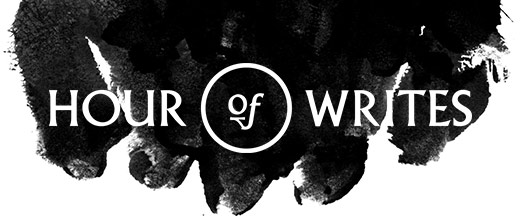Writing About Art
Entry by: EmmaCLP
5th June 2015
He flicked through his files, stopping abruptly when he came to the artist’s photograph. A woman in her fifties stood in a paint-spattered studio, staring directly into the camera. She had a tanned face, silver hair that fell to her waist and a smile that was impossible to read. Her feet were bare and she'd tucked a thin paintbrush jauntily behind her ear.
All about her the scene was chaotic. Dustsheets hung over vast canvases, a naked middle-aged woman lounged on a grubby floral sofa, a young man with chipped teeth and a patch over one eye gripped a brown and white bulldog tightly by the collar.
He’d forgotten that while other clients bound their manuscripts together with mundane rubber bands she had tied hers up with a black ribbon, painted exquisite aquamarine stars all over the title page and signed her name with a flourish in an elegant navy-blue italic script. Never mind the contents, the manuscript alone – typed on a typewriter with a dodgy ribbon – was a work of art.
He patted the photograph lovingly. He had high hopes for this book.
The artist was one of the most charismatic women he’d ever met – yet after all this time her life and work were still shrouded in mystery. He had only read the first few thousand words of her autobiography but he was already riveted by her rise from a tenement block in downtown Manhattan to fame and fortune in London. She’d promised him that the rest of her story would enthral him even more. ‘But in a good way,’ she had laughed and he hadn’t doubted her for a second.
Now he was filled with foreboding. It wasn’t his style to chase writers endlessly for their manuscripts. Not unless they were in danger of missing their deadline by miles, and even then he tried his best to be patient. But she had gone oddly silent of late. No emails, no phone calls, no word at all. She’d completely disappeared off the radar.
‘I started out as a life model,’ she’d once told him. ‘It was the only way I could survive . But I was good at it. I modelled for Dior in my twenties and artists liked the way I could hold a pose. They complained that other girls couldn’t stay still for long enough. They didn’t have the patience, I suppose. Or the stamina, or the desperation to pay the rent that I had. Life modelling is so much more than having a beautiful body, you see. It’s about creating a rapport. It’s about shapes and angles, light and shade. It’s about feeling comfortable in yourself and not caring what anyone else thinks of you.’
Snippets of their other conversations came back to him now. ‘David Hockney might mess about with iPads and stuff,’ she’d said. ‘But nothing beats the swish of a brush on a good quality canvas. Looking back, I've probably spent more time in my studio than I have with my children.'
All about her the scene was chaotic. Dustsheets hung over vast canvases, a naked middle-aged woman lounged on a grubby floral sofa, a young man with chipped teeth and a patch over one eye gripped a brown and white bulldog tightly by the collar.
He’d forgotten that while other clients bound their manuscripts together with mundane rubber bands she had tied hers up with a black ribbon, painted exquisite aquamarine stars all over the title page and signed her name with a flourish in an elegant navy-blue italic script. Never mind the contents, the manuscript alone – typed on a typewriter with a dodgy ribbon – was a work of art.
He patted the photograph lovingly. He had high hopes for this book.
The artist was one of the most charismatic women he’d ever met – yet after all this time her life and work were still shrouded in mystery. He had only read the first few thousand words of her autobiography but he was already riveted by her rise from a tenement block in downtown Manhattan to fame and fortune in London. She’d promised him that the rest of her story would enthral him even more. ‘But in a good way,’ she had laughed and he hadn’t doubted her for a second.
Now he was filled with foreboding. It wasn’t his style to chase writers endlessly for their manuscripts. Not unless they were in danger of missing their deadline by miles, and even then he tried his best to be patient. But she had gone oddly silent of late. No emails, no phone calls, no word at all. She’d completely disappeared off the radar.
‘I started out as a life model,’ she’d once told him. ‘It was the only way I could survive . But I was good at it. I modelled for Dior in my twenties and artists liked the way I could hold a pose. They complained that other girls couldn’t stay still for long enough. They didn’t have the patience, I suppose. Or the stamina, or the desperation to pay the rent that I had. Life modelling is so much more than having a beautiful body, you see. It’s about creating a rapport. It’s about shapes and angles, light and shade. It’s about feeling comfortable in yourself and not caring what anyone else thinks of you.’
Snippets of their other conversations came back to him now. ‘David Hockney might mess about with iPads and stuff,’ she’d said. ‘But nothing beats the swish of a brush on a good quality canvas. Looking back, I've probably spent more time in my studio than I have with my children.'





 Follow us on Twitter
Follow us on Twitter
 Follow us on Instagram
Follow us on Instagram